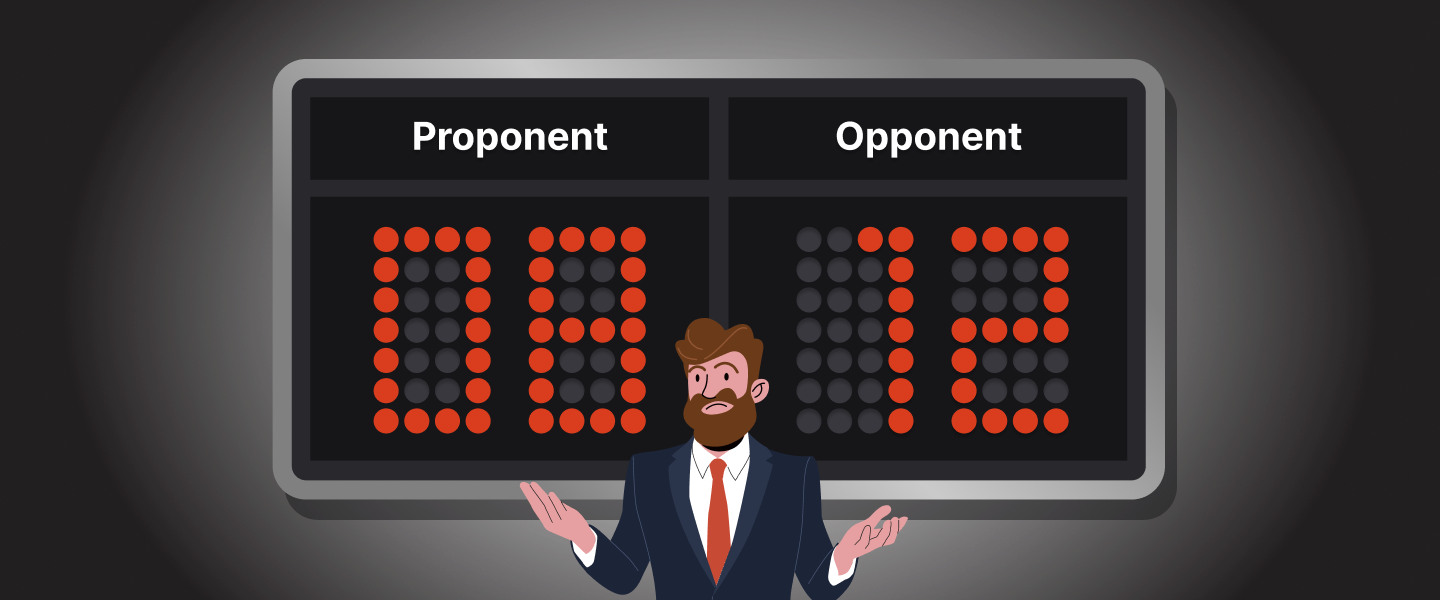Table of Contents
- The Hearsay Game
- The Hearsay-Game Objective
- The Ref’s Ruling
The Hearsay Rules

There are few evidence topics more misunderstood than hearsay. But, in the few moments it’ll take you to read this article, you’ll not only understand hearsay but will also know how the hearsay game is played and how to win it—whether it’s played in class, on a final exam, or on the bar exam.
The Hearsay Game
Here’s how the Hearsay Game is played. A court proceeding is going along just fine. A witness is answering the examining lawyer’s questions. And then, the witness mentions something he heard someone else say. Opposing counsel (“the opponent”) springs to her feet and objects, declaring, “Hearsay!” Everyone looks at the judge (“the referee”) inquisitively.
Game on.
Game on.
The Hearsay-Game Objective
The Hearsay Game’s objective is straightforward. The opponent wants to exclude the evidence. The lawyer who was examining the witness (“the proponent”) wants to admit the evidence. Whoever wins gets the point.
The Hearsay Rules
Every game has rules, and the Hearsay Game is no exception. However, unlike its objective, the Hearsay Game’s rules are not straightforward.
The most important hearsay rules are contained in Rules 801 through 804 of the Federal Rules of Evidence.
The most important hearsay rules are contained in Rules 801 through 804 of the Federal Rules of Evidence.
Rule 801
Rule 801 does 2 things. First, it defines hearsay. Second, it expressly excludes 2 categories of statements from that definition.
Rule 802
Rule 802 declares that hearsay is inadmissible unless the evidentiary rules, a federal statute, or a United States Supreme Court rule provides otherwise.
Rules 803 and 804
Collectively, Rules 803 and 804 contain 30 exceptions to the hearsay rule that cover nearly every kind of statement a person can make.
The Hearsay Moves
After the opponent’s objection, the proponent must figure out what move to make to get the evidence admitted. There are 4 general moves the proponent can make.
The definitional move
The proponent’s opening move should always be the definitional move. In this move, the proponent argues that the objectionable statement is not, in fact, hearsay as the rule defines it.
Rule 801 defines hearsay as an out-of-court statement, offered in court, to prove the truth of the matter asserted in the statement. Thus, the proponent’s definitional move involves arguing that the statement doesn’t satisfy some part of this definition. The arguments go something like this:
Rule 801 defines hearsay as an out-of-court statement, offered in court, to prove the truth of the matter asserted in the statement. Thus, the proponent’s definitional move involves arguing that the statement doesn’t satisfy some part of this definition. The arguments go something like this:
- “It’s not a statement.”
- “Even if it’s a statement, it doesn’t assert anything.”
- “Even if it’s a statement that’s an assertion, it’s not being offered to prove the assertion.”
If the proponent doesn’t score the point with the definitional move, the next move is the exclusion move.
The exclusion move
In the exclusion move, the proponent tries to get the statement admitted under one of Rule 801(d)’s express exclusions for 2 categories of statements—a declarant-witness’s prior statement or an opposing party’s statement. Failing that, the proponent will try the exception move.
The exception move
In the exception move, the proponent tries to get the statement admitted under one of the 30 exceptions set forth in Rules 803 and 804. To decide which exception to try, the proponent must first determine whether the person who made the out-of-court statement (the declarant) is available to testify at the current proceeding. This determination is important because, although Rule 803’s exceptions apply regardless of whether the declarant is available to testify at the current proceeding, Rule 804’s exclusions apply only if the declarant is unavailable (as defined by the Rules) to testify at the current proceeding. Therefore, if the declarant is available to testify at the current proceeding, the proponent may not try to admit the statement under any of Rule 804’s exceptions.
All the while, the opponent is arguing against the proponent’s moves—trying to show that the statement satisfies the definition of hearsay, isn’t expressly excluded as a declarant-witness’s prior statement or an opposing party’s statement, and doesn’t come close to satisfying even a single one of the 30 exceptions in Rules 803 and 804.
All the while, the opponent is arguing against the proponent’s moves—trying to show that the statement satisfies the definition of hearsay, isn’t expressly excluded as a declarant-witness’s prior statement or an opposing party’s statement, and doesn’t come close to satisfying even a single one of the 30 exceptions in Rules 803 and 804.
The Hail Mary move
The final move that’s important in the Hearsay Game derives from Rule 807’s residual exception. It’s the equivalent of a Hail Mary pass in football. Rule 807 gives the proponent one last-ditch chance at admitting a statement that hasn’t been admitted under the prior moves.
The residual exception permits the admission of a statement that, despite failing to satisfy any of Rule 803’s or 804’s exceptions, is, under the totality of the circumstances, sufficiently trustworthy and more probative on the matter for which it was offered than any other evidence that the proponent could reasonably obtain.
If the proponent can make this showing, it’ll win the point.
The residual exception permits the admission of a statement that, despite failing to satisfy any of Rule 803’s or 804’s exceptions, is, under the totality of the circumstances, sufficiently trustworthy and more probative on the matter for which it was offered than any other evidence that the proponent could reasonably obtain.
If the proponent can make this showing, it’ll win the point.
The Ref’s Ruling
After some back and forth between the proponent and the opponent, the referee will rule on the statement’s admissibility. Typically, the referee will make one of 4 calls—(1) admit the evidence, (2) exclude the evidence, (3) admit the evidence and instruct the jury about how it may use the evidence in deciding the case, or (4) defer the ruling until some later time.
On appeal, the referee’s evidentiary rulings are reviewable only for an abuse of discretion. Therefore, evidentiary rulings are generally upheld on review.
From your first day of law school to your final day of practice, Quimbee is here to help you succeed. Get up to speed on hearsay and other tough evidence concepts with essential video lessons, essay practice exams, and multiple-choice questions. Check out Quimbee Bar Review+ to explore the features students across the country rely on to help them pass the bar exam on their first attempt. To learn more, book a free, 30-minute course tour with a bar review director.
On appeal, the referee’s evidentiary rulings are reviewable only for an abuse of discretion. Therefore, evidentiary rulings are generally upheld on review.
From your first day of law school to your final day of practice, Quimbee is here to help you succeed. Get up to speed on hearsay and other tough evidence concepts with essential video lessons, essay practice exams, and multiple-choice questions. Check out Quimbee Bar Review+ to explore the features students across the country rely on to help them pass the bar exam on their first attempt. To learn more, book a free, 30-minute course tour with a bar review director.







